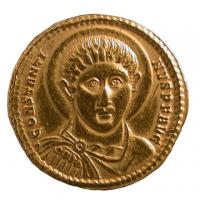GOLD COINAGE IN THE ROMAN WORLD
About the research project

Gold coin of Constantine with a 'halo', minted at Ticinum, northern Italy, AD 315.
Metallurgical analysis has long been used to determine the fineness – the purity – of ancient precious metal coinage. Recent developments in analytical techniques have begun to open up exciting new possibilities. Trace elements, present in very small quantities, can provide information about source metals or production methods and may allow researchers to distinguish coins from different mints. This new type of scientific analysis applied to coins selected from the Ashmolean’s collection of 600 Roman gold coins has the potential to provide valuable new insights. Gold Coinage in the Roman World is a Collaborative Doctoral Partnership project that will combine the use of these techniques with a broader analysis of patterns of circulation and deposition to enhance our understanding of the relationship of gold coinage to the development of Roman society and economy.
Research aims
The project, bringing together scientific and historical techniques of analysis, will seek to address the following research questions:
- The fineness of Roman gold appears remarkably stable by contrast with the silver coinage, the dramatic decline of which has been regarded as an indicator of the fiscal inadequacy of the Roman Empire. How can this apparent contradiction be resolved?
- To what extent can metallurgical analysis tell us about metal sources and flows during the Roman period as well as about the purity of the metal itself?
- At what point did gold coinage change from having a fixed nominal value to being treated like a circulating ingot?
- Was the apparent scarcity of gold in the third century AD due to export of gold from the Empire, most importantly through subsidies paid to ‘barbarians’?
- What was the nature of the major new source of gold in the fourth century AD?
- The initial provision of gold to the military in the early empire is evident, but what was the initial function of gold after that?
- By the fourth century AD control of gold appears to have become both a marker of, and a means to enhance, social hierarchy. How did this change come about?
The research will provide new data sets that will support the work of broader projects including the Coin Hoards of the Roman Empire Project and the Oxford Roman Economy Project in the University of Oxford, and the project on the analysis of Roman silver coinage at the University of Warwick. Engaging with major historical questions concerned with the resources, technology and connectivity of the Roman world, the project has the potential to inform thinking across many areas of Classical Archaeology and Ancient History and to generate new approaches to research in these disciplines.
Project funders
Arts and Humanities Research Council (AHRC) Collaborative Doctoral Partnership (CDP) Scheme
Ashmolean Museum Collaborative Doctoral Partnerships
Project start
October 2016
CDP Student
George Green, University of Warwick
CDP Supervisors
Professor Chris Howgego, Ashmolean Museum, University of Oxford
Professor Kevin Butcher, University of Warwick
Professor Mark Pollard, University of Oxford




